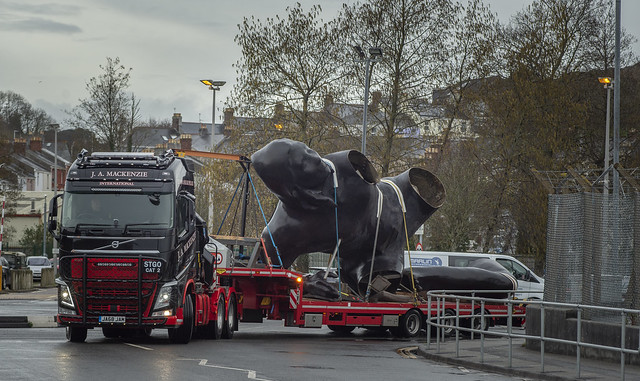
Love her or hate her, Messenger has become a familiar Plymouth landmark, welcoming thousands of people into the theatre every year.
Today, we’re celebrating six years since this incredible cast bronze sculpture, the UK’s largest in fact, was lowered onto her home on Royal Parade.
Created by Cornish-born artist Joseph Hillier, Messenger was inspired by a character from Frantic Assembly’s award-winning interpretation of Othello, which was first performed at the theatre in 2008.
Here’s a timeline of events which led up to Messenger’s installation in March 2019:
2014
The story of Messenger goes back to 2014. Following the theatre’s regeneration project, TRP commissioned Joseph Hillier to create an exhibition marking its completion. Joseph captured 3D images of actors while they rehearsed Othello. From these 3D images, he created sculptural figures.
He then had the idea to turn one of the figures into a large-scale sculpture for outside the theatre. And so, the idea for Messenger was born!
11 October 2016
TRP unveiled plans for the statue in October 2016 when a planning application was submitted to the council.
TRP’s CEO at the time Adrian Vinken said:
“When we completed the regeneration project we wanted to install something outside the building that reflected the creativity that is at the heart of it.
“A statue such as this will have a transformational impact not just on the theatre, but the whole of the city of Plymouth. A major piece of public art transforms the world’s perception of what a place is like; it makes a statement about a city that it’s modern, it’s contemporary and it’s on the move.
“It will be a brilliant thing for the city. It will be one of those iconic structures that destinations become forever associated with.”
9 February 2017
Despite a mixed response to the plans, permission for Messenger was granted by Plymouth City Council in February 2017, giving the green light for work to begin.
It was revealed the sculpture would cost around £450,000 to create, with the money coming entirely from cash that was earmarked for a piece of public art as part of the theatre’s regeneration project.
7 November 2017
Nine months later, in November 2017, work finally began on creating the giant bronze sculpture. A skilled team of craftspeople at Castle Fine Arts Foundry in Wales began the centuries-old lost-wax process of bronze casting.
Joseph Hillier also revealed her name: Messenger. Until then, she had been known as Bianca, the name of a character in Othello.
As Messenger began taking shape, theatre staff began working out how they would bring this huge piece of public art from Wales to her new home in Plymouth in time for the official unveiling.
March 2019
Messenger weighs around 10 tonnes, so transporting her from Wales to Plymouth was no easy task!
She left Castle Fine Arts Foundry in sections and was transported to Plymouth by road. The sections arrived at Devonport Naval Base, where they were welded together by a team from the Foundry.
18 March 2019
Messenger’s arrival into Plymouth was by sea, of course! We are Britain’s Ocean City after all. Much to the amazement of onlookers, she was put onto a barge and sailed across Plymouth Sound to Millbay Docks. From there she was craned onto a low-loader.
As she made her way through the city’s streets, crowds got their first glimpse of Messenger and watched as she was gently craned into position, whilst theatre staff held their breath until the moment her feet touched the ground.
22 March 2019
Messenger was lit up for the first time on 22 March 2019. Nicola Kavanagh, the actor whose fleeting movement inspired Messenger’s creation, was in attendance to switch on the lights as part of an official ceremony, attended by special guests and the press.
Ever since that moment, Messenger has stood proud outside TRP. She has not only become a symbol for the theatre but also for the city. She was even the subject of her own documentary, which aired on Sky Arts in 2019, narrated by Dawn French.
Six years on, Messenger remains controversial. Whatever you think of her, she’s ours, and we love her!
